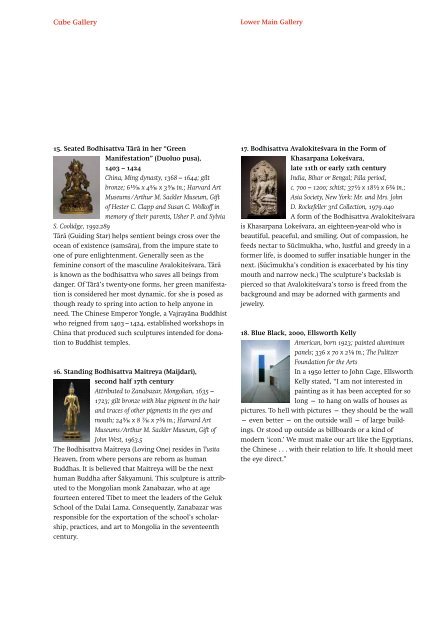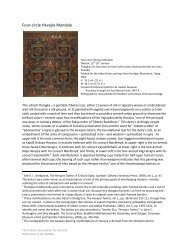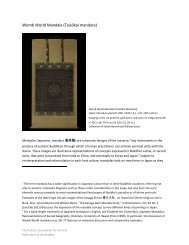Reflections of the Buddha - The Pulitzer Foundation for the Arts
Reflections of the Buddha - The Pulitzer Foundation for the Arts
Reflections of the Buddha - The Pulitzer Foundation for the Arts
You also want an ePaper? Increase the reach of your titles
YUMPU automatically turns print PDFs into web optimized ePapers that Google loves.
Cube Gallery Lower Main Gallery<br />
15. Seated Bodhisattva Tārā in her “Green<br />
Manifestation” (Duoluo pusa),<br />
1403 – 1424<br />
China, Ming dynasty, 1368 – 1644; gilt<br />
bronze; 6� x 4� x 3� in.; Harvard Art<br />
Museums / Arthur M. Sackler Museum, Gift<br />
<strong>of</strong> Hester C. Clapp and Susan C. Wolk<strong>of</strong>f in<br />
memory <strong>of</strong> <strong>the</strong>ir parents, Usher P. and Sylvia<br />
S. Coolidge, 1992.289<br />
Tārā (Guiding Star) helps sentient beings cross over <strong>the</strong><br />
ocean <strong>of</strong> existence (samsāra), from <strong>the</strong> impure state to<br />
one <strong>of</strong> pure enlightenment. Generally seen as <strong>the</strong><br />
feminine consort <strong>of</strong> <strong>the</strong> masculine Avalokiteśvara, Tārā<br />
is known as <strong>the</strong> bodhisattva who saves all beings from<br />
danger. Of Tārā’s twenty-one <strong>for</strong>ms, her green manifestation<br />
is considered her most dynamic, <strong>for</strong> she is posed as<br />
though ready to spring into action to help anyone in<br />
need. <strong>The</strong> Chinese Emperor Yongle, a Vajrayāna Buddhist<br />
who reigned from 1403 – 1424, established workshops in<br />
China that produced such sculptures intended <strong>for</strong> donation<br />
to Buddhist temples.<br />
16. Standing Bodhisattva Maitreya (Maijdari),<br />
second half 17th century<br />
Attributed to Zanabazar, Mongolian, 1635 –<br />
1723; gilt bronze with blue pigment in <strong>the</strong> hair<br />
and traces <strong>of</strong> o<strong>the</strong>r pigments in <strong>the</strong> eyes and<br />
mouth; 24� x 8 � x 7⅝ in.; Harvard Art<br />
Museums / Arthur M. Sackler Museum, Gift <strong>of</strong><br />
John West, 1963.5<br />
<strong>The</strong> Bodhisattva Maitreya (Loving One) resides in Tusita<br />
Heaven, from where persons are reborn as human<br />
<strong>Buddha</strong>s. It is believed that Maitreya will be <strong>the</strong> next<br />
human <strong>Buddha</strong> after Śākyamuni. This sculpture is attributed<br />
to <strong>the</strong> Mongolian monk Zanabazar, who at age<br />
fourteen entered Tibet to meet <strong>the</strong> leaders <strong>of</strong> <strong>the</strong> Geluk<br />
School <strong>of</strong> <strong>the</strong> Dalai Lama. Consequently, Zanabazar was<br />
responsible <strong>for</strong> <strong>the</strong> exportation <strong>of</strong> <strong>the</strong> school’s scholarship,<br />
practices, and art to Mongolia in <strong>the</strong> seventeenth<br />
century.<br />
17. Bodhisattva Avalokiteśvara in <strong>the</strong> Form <strong>of</strong><br />
Khasarpana Lokeśvara,<br />
late 11th or early 12th century<br />
India, Bihar or Bengal; Pāla period,<br />
c. 700 – 1200; schist; 37½ x 18½ x 6¾ in.;<br />
Asia Society, New York: Mr. and Mrs. John<br />
D. Rockefeller 3rd Collection, 1979 . 040<br />
A <strong>for</strong>m <strong>of</strong> <strong>the</strong> Bodhisattva Avalokiteśvara<br />
is Khasarpana Lokeśvara, an eighteen-year-old who is<br />
beautiful, peaceful, and smiling. Out <strong>of</strong> compassion, he<br />
feeds nectar to Sūcīmukha, who, lustful and greedy in a<br />
<strong>for</strong>mer life, is doomed to suffer insatiable hunger in <strong>the</strong><br />
next. (Sūcīmukha’s condition is exacerbated by his tiny<br />
mouth and narrow neck.) <strong>The</strong> sculpture’s backslab is<br />
pierced so that Avalokiteśvara’s torso is freed from <strong>the</strong><br />
background and may be adorned with garments and<br />
jewelry.<br />
18. Blue Black, 2000, Ellsworth Kelly<br />
American, born 1923; painted aluminum<br />
panels; 336 x 70 x 2⅛ in.; <strong>The</strong> <strong>Pulitzer</strong><br />
<strong>Foundation</strong> <strong>for</strong> <strong>the</strong> <strong>Arts</strong><br />
In a 1950 letter to John Cage, Ellsworth<br />
Kelly stated, “I am not interested in<br />
painting as it has been accepted <strong>for</strong> so<br />
long — to hang on walls <strong>of</strong> houses as<br />
pictures. To hell with pictures — <strong>the</strong>y should be <strong>the</strong> wall<br />
— even better — on <strong>the</strong> outside wall — <strong>of</strong> large buildings.<br />
Or stood up outside as billboards or a kind <strong>of</strong><br />
modern ‘icon.’ We must make our art like <strong>the</strong> Egyptians,<br />
<strong>the</strong> Chinese . . . with <strong>the</strong>ir relation to life. It should meet<br />
<strong>the</strong> eye direct.”




